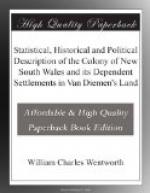The timber procured on the banks of this river is chiefly cedar and rose wood. The cedar, however, is becoming scarce in consequence of the immense quantities that have been already cut down, and cannot be any longer obtained without going at least a hundred and fifty miles up the river. At this distance, however, it is still to be had in considerable abundance, and is easily floated down to the town in rafts. The government dispose of this wood in the same manner as the coals, at the price of L3 for each thousand square feet, intended for home consumption, and L6 for the same quantity if exported.
This settlement is placed under the direction of a commandant, who is selected out of the officers of the regiment stationed in the colony, and is allowed, as has been noticed, about fifty fire-locks to maintain his authority. He is always appointed to the magistracy previously to his obtaining this command, and is entrusted with the entire controul of the prisoners, whom he punishes or rewards as their conduct may appear to him to merit.
The harbour at the mouth of this river is tolerably secure and spacious, and contains sufficient depth of water for vessels of three hundred tons burden. The river itself, however, is only navigable for small craft of thirty or forty tons burden, and this only for about fifty miles above the town. Just beyond this distance there are numerous flats and shallows, which only admit of the passage of boats over them. This river has three branches; they are called the upper, the lower, and the middle branch: the two former are navigable for boats for about a hundred and twenty miles, the latter for upwards of two hundred miles. The banks of all these branches are liable to inundations equally terrific with those at the Hawkesbury, and from the same causes; because they are receptacles for the rain that is collected by the Blue Mountains, which form the western boundary of this district, and divide it as well as the districts of Port Jackson, from the great western wilderness. The low lands within the reach of these inundations is if possible of still greater exuberancy than the banks of the Hawkesbury and Nepean, and of four times the extent. The high-land, or to give it the colonial appellation, the forest land, is very thinly studded with timber, and equal for all the purposes of agriculture and grazing to the best districts of Port Jackson. The climate too is equally salubrious, and on the upper banks of the middle branch, it is generally believed, that the summer heats are sufficient for the production of cotton; the cultivation of which would become an inexhaustible source of wealth to the growers, and would afford a valuable article of export to the colony.




